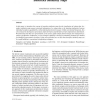Free Online Productivity Tools
i2Speak
i2Symbol
i2OCR
iTex2Img
iWeb2Print
iWeb2Shot
i2Type
iPdf2Split
iPdf2Merge
i2Bopomofo
i2Arabic
i2Style
i2Image
i2PDF
iLatex2Rtf
Sci2ools
CGF
2010
2010
Isosurface Similarity Maps
In this paper, we introduce the concept of isosurface similarity maps for the visualization of volume data. Isosurface similarity maps present structural information of a volume data set by depicting similarities between individual isosurfaces quantified by a robust information-theoretic measure. Unlike conventional histograms, they are not based on the frequency of isovalues and/or derivatives and therefore provide complementary information. We demonstrate that this new representation can be used to guide transfer function design and visualization parameter specification. Furthermore, we use isosurface similarity to develop an automatic parameter-free method for identifying representative isovalues. Using real-world data sets, we show that isosurface similarity maps can be a useful addition to conventional classification techniques. Categories and Subject Descriptors (according to ACM CCS): I.3.3 [Computer Graphics]: Picture/Image Generation--Display algorithms
| Added | 09 Dec 2010 |
| Updated | 09 Dec 2010 |
| Type | Journal |
| Year | 2010 |
| Where | CGF |
| Authors | Stefan Bruckner, Torsten Möller |
Comments (0)

